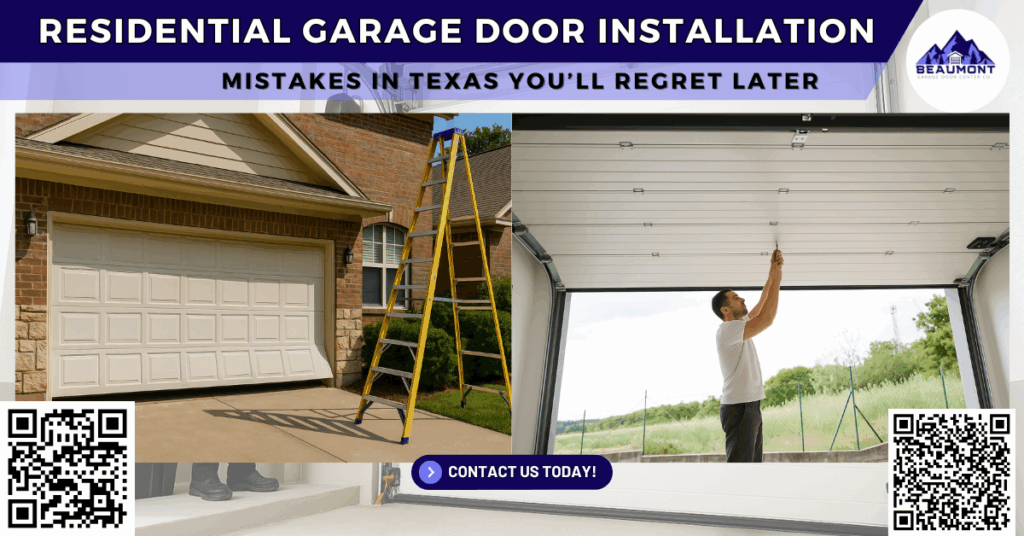Not long ago, in Bevil Oaks, TX, we received a call from a homeowner frustrated by their new garage door. They had recently replaced their old door themselves using a discounted DIY garage door installation kit. Unfortunately, within weeks, the bottom panel began to warp, the garage door opener started malfunctioning, and the garage door stopped providing smooth operation altogether. After inspecting the setup, we discovered several major issues: misaligned vertical tracks, improper spring tension on the torsion springs, missing safety sensors, and a weak flag bracket that couldn’t hold the horizontal tracks in place. Their attempt to save money had led to a costly repair and replacement project.
According to the U.S. Consumer Product Safety Commission, garage doors are responsible for over 30,000 injuries annually, many due to improper installation, lack of safety features, and poor maintenance. Your garage door may seem like just another part of your home, but it’s a complex system involving springs, tracks, cables, brackets, panels, and a powerful opener, all of which need to work in harmony for proper and safe operation.
If you’re planning a residential garage door installation in Texas, it’s crucial to understand the common pitfalls that homeowners often encounter. Whether you’re upgrading to a new garage door or replacing an aging one, avoiding these mistakes will save you time, money, and stress and protect your home’s value and security.
1. Choosing the Wrong Garage Door for Texas Weather Conditions
Texas is known for its extreme temperatures, high humidity, and severe storms. A garage door that lacks proper insulation or durability can dramatically increase your energy consumption and fail prematurely.
Many homeowners unknowingly purchase doors without considering insulation, R-value, or wind resistance. For example, installing a non-insulated steel door in areas like Beaumont or Bevil Oaks leads to unbearable garage temperatures during summer months and heat loss in winter. This not only affects comfort but also damages stored belongings and raises utility bills.
Better Approach:
Choose a garage door material suitable for your climate. Insulated garage doors, especially those with a high R-value, are ideal for energy efficiency and temperature control. Look for steel doors with polyurethane or polystyrene insulation for the best performance. In hurricane-prone regions, always install wind-rated overhead doors that meet the Texas Department of Insurance guidelines. Consult the manufacturer’s specifications for climate suitability and insulation properties.
2. Skipping Insulation for Attached Garages
Some homeowners think insulation is only necessary if the garage is used as a living space. In reality, uninsulated garage door panels contribute significantly to temperature fluctuations that affect rooms adjacent to or above the garage. This mistake often results in higher energy costs and inconsistent comfort.
Better Approach:
Even if you don’t use your garage daily, insulated garage door panels reduce energy consumption, minimize garage door opener strain, and contribute to a quieter, more efficient home. Prioritize models with foam-injected cores and thermal breaks. Pay attention to garage door sections like the bottom panel, which often face the most exposure. The top section also plays a role in sealing the door to the ceiling or garage opening.
3. Attempting DIY Garage Door Installation Without Experience
Garage door installation involves more than simply hanging panels and plugging in an opener. It’s a precision task requiring the correct handling of torsion springs, garage door tracks, and hinges. Improper spring tension or track misalignment can cause major safety hazards or complete system failure.
Better Approach:
While DIY culture has its appeal, garage door installation is best left to professionals. Experienced technicians follow a step-by-step guide, using necessary tools like vise grips, zinc hex lag screws, torque wrenches, and spring winding bars to ensure safe assembly. A successful garage door installation includes perfectly aligned vertical tracks, a securely mounted center bracket, properly wound torsion springs, and a garage door opener rated for your door’s weight.
4. Using the Wrong Type or Size of Springs
Garage door springs, either torsion springs or extension springs, counterbalance the door’s weight, enabling smooth operation. Using mismatched or weak springs can lead to sudden snapping, jerky motion, or a total breakdown.
Better Approach:
Spring selection must be based on precise weight calculations of the installed door. A professional will weigh the garage door panels to determine the correct spring tension and coil length. This includes proper installation of the spring cone, torsion tube, and drums that secure the lift cables. Replacing springs without the right knowledge or tools can result in injury or death, so this is never a DIY step.
5. Misaligning the Garage Door Tracks
Garage doors operate by rolling along a pair of vertical and horizontal tracks. If these tracks are bent, misaligned, or installed with the wrong bracket placement, your door may catch, drag, or fall off-track entirely.
Better Approach:
During professional installation, the vertical track is securely mounted to the wall using flag brackets and measured precisely to ensure plumb installation. The horizontal tracks must be level, supported by angle iron or perforated angle brackets fixed to the ceiling joists. Missteps here lead to excessive wear on the rollers and opener.
6. Insecure Mounting and Weak Brackets
The brackets that hold your garage door system together play a crucial role in supporting its weight and maintaining alignment. Installing these incorrectly, especially the flag bracket, center bracket, or end brackets, can cause long-term instability and danger during operation.
Better Approach:
Use heavy-duty steel brackets approved by the garage door manufacturer. Anchor them with lag bolts into framing studs, never drywall or weak materials. For proper door function, the center support bracket must hold the torsion tube securely in place, while side brackets must be bolted with precision.
7. Underrated or Overpowered Garage Door Opener
Not all garage door openers are created equal. An opener with too little horsepower for a large or insulated door will wear out quickly, while an overpowered opener may cause abrupt starts and stops, damaging internal components.
Better Approach:
Match the garage door opener to your door’s weight, usage frequency, and type. A ½ HP opener is sufficient for most single aluminum doors, while ¾ HP or 1 HP openers are better for double doors, insulated doors, or wood garage doors. Install with safety in mind by using reinforcement brackets, emergency release cords, and ceiling-mounted tracks to allow stable motion.
8. Neglecting Required Safety Features
Modern garage doors come with safety sensors, auto-reverse mechanisms, and manual release systems to protect people and property. Ignoring or improperly installing these devices puts everyone in danger.
Better Approach:
Ensure that infrared safety sensors are mounted 4–6 inches above the garage floor and aligned precisely. Test them after installation to confirm the door reverses when an object interrupts the beam. Confirm that the emergency release handle is easily reachable and that all installation instructions for safety features are strictly followed.
9. Poor Panel Leveling and Loose Hinges
If the garage door panels are not level, flush, and tightly connected with hinges, your door will become noisy, unbalanced, and unprofessional in appearance. Misaligned panels can damage weatherstripping, increase friction, and impair operation.
Better Approach:
Install panels from the bottom section up. Ensure each section is plumb and square before proceeding. Use shims where necessary and tighten all bolts securely. Use proper hinge sizes depending on the panel’s location in the door stack. A garage door installation guide will show which numbered hinges go where.
10. Skipping Routine Maintenance After Installation
Many homeowners think their job is done once the new garage door is installed. But neglecting regular maintenance causes premature wear, reduced energy efficiency, and noisy operation. Dirt buildup, spring fatigue, and track obstructions are common issues over time.
Better Approach:
Schedule annual garage door tune-ups. A professional will inspect all moving parts, test the garage door opener, check spring tension, lubricate rollers, drums, hinges, and clean the tracks. Routine care extends the life of your system and ensures continued safe operation.
How Can Beaumont Garage Door Center Co. Help You?
At Beaumont Garage Door Center Co., we provide professional garage door installation services that eliminate guesswork, avoid costly mistakes, and deliver lasting results. Whether you’re replacing an old door, upgrading your garage door opener, or customizing a new look to improve curb appeal, our experienced team has you covered.
We use only manufacturer-approved materials, follow precise installation instructions, and double-check all components for safety and performance. We handle every part of the installation process from securing the torsion springs to aligning the garage door panels, installing insulation, setting up safety sensors, and reinforcing your system with durable brackets and hardware.
Here’s What We Offer:
- Expert consultation for choosing the right style, material, and insulation
- Full system installation using quality tools, brackets, and torsion systems
- Safety compliance with properly installed photo-eyes, auto-reverse sensors, and emergency systems
- Post-installation maintenance plans for worry-free operation
- Emergency repairs and upgrades for all garage door systems
📍 Visit Us At: Eastex Fwy, Beaumont, TX 77706
📞 Call Now: (409) 219-5723
🌐 Your garage door deserves expert attention. Trust the local pros to do it right.
Don’t let preventable mistakes become expensive regrets. Contact Beaumont Garage Door Center Co. today for reliable, safe, and efficient residential garage door installation across Bevil Oaks, Beaumont, and surrounding Texas communities!
Frequently Asked Questions
1. How long does a residential garage door installation usually take?
A professional garage door installation typically takes 4 to 6 hours, depending on the size, style, and complexity of the door system.
2. Do I need a permit to install a new garage door in Texas?
In many Texas cities, a permit is required for garage door installation, especially if structural modifications are involved. Check with your local building department.
3. Can I reuse my old garage door opener with a new door?
It depends on the opener’s age, horsepower, and compatibility; in most cases, older openers lack the power or safety features required for modern doors.
4. What is the average lifespan of a newly installed garage door?
With proper installation and routine maintenance, a residential garage door can last 15 to 30 years, depending on material quality and usage.

